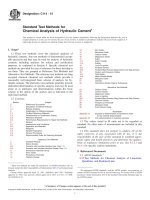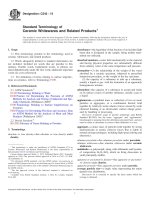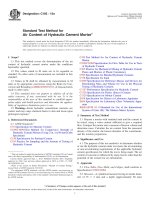Astm c 695 15
Bạn đang xem bản rút gọn của tài liệu. Xem và tải ngay bản đầy đủ của tài liệu tại đây (128.26 KB, 3 trang )
Designation: C695 − 15
An American National Standard
Standard Test Method for
Compressive Strength of Carbon and Graphite1
This standard is issued under the fixed designation C695; the number immediately following the designation indicates the year of
original adoption or, in the case of revision, the year of last revision. A number in parentheses indicates the year of last reapproval. A
superscript epsilon (´) indicates an editorial change since the last revision or reapproval.
This standard has been approved for use by agencies of the U.S. Department of Defense.
1. Scope*
5. Apparatus
1.1 This test method covers the determination of the compressive strength of carbon and graphite at room temperature.
5.1 Test Machine, conforming to Practice E4 and to the
requirements for speed of testing prescribed in Section 8 of this
test method.
1.2 The values stated in inch-pound units are to be regarded
as standard. The values given in parentheses are mathematical
conversions to SI units that are provided for information only
and are not considered standard.
1.3 This standard does not purport to address all of the
safety concerns, if any, associated with its use. It is the
responsibility of the user of this standard to establish appropriate safety and health practices and determine the applicability of regulatory limitations prior to use.
5.2 Spherical Bearing Blocks attached to the upper or lower
head of the machine in such a manner that the spherical
surfaces are in full contact when not loaded. The center of
curvative of the spherical surface shall lie on the surface that
contacts the specimen and on the machine axis. The spherical
surfaces shall be well-lubricated. The radius of the spherical
surface shall be equal to or greater than the radius of the test
specimen.
5.3 Steel Contact Blocks may be used above or below the
specimen, or both, to protect fixture and test machine surfaces
from damage, as illustrated in Fig. 1 and Fig. 2. Contact block
surfaces shall be plane and parallel to within 0.0005 in./in.
(0.0005 mm/mm).
2. Referenced Documents
2.1 ASTM Standards:2
E4 Practices for Force Verification of Testing Machines
E177 Practice for Use of the Terms Precision and Bias in
ASTM Test Methods
E691 Practice for Conducting an Interlaboratory Study to
Determine the Precision of a Test Method
5.4 All load-bearing machine and fixture surfaces shall have
a minimum hardness of 45 HRC and surface finish of 16 µin.
(0.4 µm) rms maximum. Surfaces in contact with the specimen
shall be flat to less than 0.0005 in./in. (0.0005 mm/mm).
3. Terminology
5.5 Examples of arrangements of the load train are shown
schematically in Fig. 1 and Fig. 2.
3.1 Definitions:
3.1.1 compressive strength, n—property of solid material
that indicates its ability to withstand a uniaxial compressive
load.
6. Sampling
6.1 Samples may be taken from locations and orientations
that satisfy the objectives of the test.
4. Significance and Use
4.1 Carbon and graphite can usually support higher loads in
compression than in any other mode of stress. This test,
therefore, provides a measure of the maximum load-bearing
capability of carbon and graphite objects.
7. Test Specimen
7.1 The test specimen shall be a right cylinder with ends
machined to yield planar and parallel faces. These faces shall
be perpendicular to the cylindrical surface to within 0.001
in./in. (0.001 mm/mm) of diameter total indicator reading. All
surfaces shall have a surface finish visually comparable to 32
µin. (0.8 µm) rms or better. Reasonable care should be
exercised to assure that all edges are sharp and without chips or
other flaws.
1
This test method is under the jurisdiction of ASTM Committee D02 on
Petroleum Products, Liquid Fuels, and Lubricants and is the direct responsibility of
Subcommittee D02.F0 on Manufactured Carbon and Graphite Products.
Current edition approved June 1, 2015. Published July 2015. Originally approved
in 1971. Last previous edition approved in 2010 as C695 – 91 (2010). DOI:
10.1520/C0695-15.
2
For referenced ASTM standards, visit the ASTM website, www.astm.org, or
contact ASTM Customer Service at For Annual Book of ASTM
Standards volume information, refer to the standard’s Document Summary page on
the ASTM website.
7.2 The diameter of the test specimen shall be greater than
ten times the maximum particle size of the carbon or graphite.
The ratio of height to diameter may vary between 1.9 and 2.1.
*A Summary of Changes section appears at the end of this standard
Copyright © ASTM International, 100 Barr Harbor Drive, PO Box C700, West Conshohocken, PA 19428-2959. United States
1
C695 − 15
FIG. 1
FIG. 2
Elements of Compressive Strength Load Train
Compressive Test Arrangement with Spherical Blocks on Bottom
The recommended minimum test specimen size is 3⁄8 in. (9.5
mm) diameter by 3⁄4 in. (19 mm) high.
9. Calculation
9.1 Calculate the compressive strength of each specimen as
follows:
8. Procedure
C 5 W/A
8.1 Center the specimen in the machine between the contact
surfaces. The deviation of the specimen axis from the machine
axis shall be less than 5 % of the specimen diameter. Centering
can be assisted by appropriate circles marked on the contact
surfaces.
where:
C = compressive strength of specimen, psi (or MPa),
W = total load on the specimen at failure, lbf (or N), and
A = calculated area of the gage section of the specimen, in.2
(or mm2).
8.2 Place an appropriate guard around the specimen to
deflect flying fragments at failure.
10. Report
8.3 Apply the load continuously, at a constant rate of
crosshead or platen movement, and without shock until ultimate failure. Choose the rate of movement so that average
rupture time is greater than 30 s.
10.1 The report shall include the following:
10.1.1 Type of testing machine, hydraulic or screw,
10.1.2 Type and size of contact blocks,
10.1.3 General description of material being tested,
10.1.4 Dimensions, location, and orientation of specimens,
10.1.5 Details of specimen preparation,
8.4 If the test machine is equipped with a load or strain
pacing device, a constant load or strain rate may be used.
2
C695 − 15
using Practice E177 definition with the pooled standard deviation calculated using Practice E691:
10.1.6 Rate of crosshead or platen movement, or load rate,
or strain rate,
10.1.7 Load at failure, failure mode, and compressive
strength of each specimen, and
10.1.8 Mean compressive strength and standard deviation
for material tested.
Repeatability within laboratory 5 2 ~ S r ! j
which yields a value for the materials used in the round robin
of 469 psi (3.2 MPa) for one material and 522 psi (3.6 MPa) for
the other. These values convert into strength percentages of 65
for one material and 62.5 for the other.
11.1.3 Repeatability (Multi-Instrument)— The precision between laboratories of two single values of measured strength
using Practice E177 definition with the component of variance
between laboratories calculated using Practice E691 is:
11. Precision and Bias3
11.1 Precision—The precision statements given in this section are based on the comparison of the mean strength by the
Student “t” test and carrying out the statistical analysis of the
data obtained in a round robin as recommended by Practice
E691. The round robin was carried out on two materials.
11.1.1 Comparison of the Means—The comparison of the
means by the Student “t” test leads to the conclusion that the
average strength values measured by each laboratory on each
material can be considered statistically equal at 95 % confidence level.
11.1.2 Repeatability (Single Instrument)— The precision
within laboratory of two single values of measured strength
Repeatability between laboratories 5 2 ~ S L ! j
which yields a value for the materials used in this round
robin of 347 psi (2.4 MPa) for one material and 135 psi (1
MPa) for the other. This converts into strength percentages of
63 for one material and 61 for the other.
11.2 Bias—No true statement on bias can be made because
no reference carbon or graphite material exists.
12. Keywords
3
Supporting data have been filed at ASTM International Headquarters and may
be obtained by requesting Research Report RR:C05-1010.
12.1 carbon; compressive strength; graphite
SUMMARY OF CHANGES
Subcommittee D02.F0 has identified the location of selected changes to this standard since the last issue
(C695 – 91 (2010)) that may impact the use of this standard. (Approved June 1, 2015.)
(1) Revised Section 3.
ASTM International takes no position respecting the validity of any patent rights asserted in connection with any item mentioned
in this standard. Users of this standard are expressly advised that determination of the validity of any such patent rights, and the risk
of infringement of such rights, are entirely their own responsibility.
This standard is subject to revision at any time by the responsible technical committee and must be reviewed every five years and
if not revised, either reapproved or withdrawn. Your comments are invited either for revision of this standard or for additional standards
and should be addressed to ASTM International Headquarters. Your comments will receive careful consideration at a meeting of the
responsible technical committee, which you may attend. If you feel that your comments have not received a fair hearing you should
make your views known to the ASTM Committee on Standards, at the address shown below.
This standard is copyrighted by ASTM International, 100 Barr Harbor Drive, PO Box C700, West Conshohocken, PA 19428-2959,
United States. Individual reprints (single or multiple copies) of this standard may be obtained by contacting ASTM at the above
address or at 610-832-9585 (phone), 610-832-9555 (fax), or (e-mail); or through the ASTM website
(www.astm.org). Permission rights to photocopy the standard may also be secured from the Copyright Clearance Center, 222
Rosewood Drive, Danvers, MA 01923, Tel: (978) 646-2600; />
3









